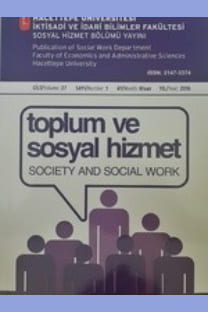Sosyal Hizmette Bir Postmodern Terapi Olarak Anlatı Terapisi
<!--
/* Font Definitions */
@font-face
{font-family:Arial;
panose-1:2 11 6 4 2 2 2 2 2 4;
mso-font-charset:0;
mso-generic-font-family:auto;
mso-font-pitch:variable;
mso-font-signature:-536859905 -1073711037 9 0 511 0;}
@font-face
{font-family:"Cambria Math";
panose-1:2 4 5 3 5 4 6 3 2 4;
mso-font-charset:0;
mso-generic-font-family:auto;
mso-font-pitch:variable;
mso-font-signature:-536870145 1107305727 0 0 415 0;}
@font-face
{font-family:Calibri;
panose-1:2 15 5 2 2 2 4 3 2 4;
mso-font-charset:0;
mso-generic-font-family:auto;
mso-font-pitch:variable;
mso-font-signature:-536870145 1073786111 1 0 415 0;}
/* Style Definitions */
p.MsoNormal, li.MsoNormal, div.MsoNormal
{mso-style-unhide:no;
mso-style-qformat:yes;
mso-style-parent:"";
margin-top:6.0pt;
margin-right:0cm;
margin-bottom:6.0pt;
margin-left:0cm;
text-align:justify;
line-height:150%;
mso-pagination:widow-orphan;
font-size:11.0pt;
font-family:Arial;
mso-fareast-font-family:"Times New Roman";
mso-bidi-font-family:"Times New Roman";}
.MsoChpDefault
{mso-style-type:export-only;
mso-default-props:yes;
font-size:10.0pt;
mso-ansi-font-size:10.0pt;
mso-bidi-font-size:10.0pt;
font-family:Calibri;
mso-ascii-font-family:Calibri;
mso-hansi-font-family:Calibri;}
@page WordSection1
{size:612.0pt 792.0pt;
margin:70.85pt 70.85pt 70.85pt 70.85pt;
mso-header-margin:35.4pt;
mso-footer-margin:35.4pt;
mso-paper-source:0;}
div.WordSection1
{page:WordSection1;}
-->
Bu
çalışmanın temel amacı anlatı terapisinin kuramsal dayanaklarını ve
tekniklerini tartışmak ve sosyal hizmet açısından sunduğu imkânları görünür
kılmaktır. Sosyal hizmet özü itibariyle modernizmden temel alır. Bu nedenle
sosyal hizmetteki teori, yaklaşım ve uygulamaların çoğunlukla modernist
paradigmadan beslendiği söylenebilir. Oysa anlatı terapisi postmodern bir
terapi biçimidir. Anlatı terapisi, sosyal inşacılık ve post-yapısalcılık gibi
kuramsal dayanaklara sahiptir. Klasik sosyal hizmet uygulamaları ve
psikoterapilerde, problemleri bireyin kişiliğinin bir parçası olarak ele alma
ve patolojik bir bakış hâkimdir. Oysa sosyal inşacı yaklaşımı benimseyen anlatı
terapisinde danışman patoloji ya da eksikliğe değil, sosyal ve kültürel
süreçlere odaklanmaktadır. Anlatı terapisinde kullanılan en önemli teknik,
bireyi problemin dışına çekmeye yarayan dışsallaştırma tekniğidir. Anlatı
terapisi, temel olarak insanların probleme doygun baskın anlatılarını yapı-sökümüne
uğratmak ve onların alternatif hikâyelerinden yeni bir anlatı inşa etmek
üzerine kuruludur. Bu nedenle anlatı terapisinin öne sürdüğü argümanların,
sorgusuz sualsiz kabul edilen gerçeklikleri sarstığı ve sosyal hizmetin
gelişimi için yeni bir kapı araladığı söylenebilir.
Narrative Therapy As a Postmodern Therapy in Social Work
<!--
/* Font Definitions */
@font-face
{font-family:Arial;
panose-1:2 11 6 4 2 2 2 2 2 4;
mso-font-charset:0;
mso-generic-font-family:auto;
mso-font-pitch:variable;
mso-font-signature:-536859905 -1073711037 9 0 511 0;}
@font-face
{font-family:"Cambria Math";
panose-1:2 4 5 3 5 4 6 3 2 4;
mso-font-charset:0;
mso-generic-font-family:auto;
mso-font-pitch:variable;
mso-font-signature:-536870145 1107305727 0 0 415 0;}
@font-face
{font-family:Calibri;
panose-1:2 15 5 2 2 2 4 3 2 4;
mso-font-charset:0;
mso-generic-font-family:auto;
mso-font-pitch:variable;
mso-font-signature:-536870145 1073786111 1 0 415 0;}
/* Style Definitions */
p.MsoNormal, li.MsoNormal, div.MsoNormal
{mso-style-unhide:no;
mso-style-qformat:yes;
mso-style-parent:"";
margin-top:6.0pt;
margin-right:0cm;
margin-bottom:6.0pt;
margin-left:0cm;
text-align:justify;
line-height:150%;
mso-pagination:widow-orphan;
font-size:11.0pt;
font-family:Arial;
mso-fareast-font-family:"Times New Roman";
mso-bidi-font-family:"Times New Roman";}
.MsoChpDefault
{mso-style-type:export-only;
mso-default-props:yes;
font-size:10.0pt;
mso-ansi-font-size:10.0pt;
mso-bidi-font-size:10.0pt;
font-family:Calibri;
mso-ascii-font-family:Calibri;
mso-hansi-font-family:Calibri;}
@page WordSection1
{size:612.0pt 792.0pt;
margin:70.85pt 70.85pt 70.85pt 70.85pt;
mso-header-margin:35.4pt;
mso-footer-margin:35.4pt;
mso-paper-source:0;}
div.WordSection1
{page:WordSection1;}
-->
The main aim
of this paper is to discuss theoretical foundation and techniques of narrative
therapy and to make its potentials visible for social work. Social work
quintessentially grounds on modernism. Thus, it can be stated that theories,
perspectives and practices in social work are mainly based on modernist
paradigm. However, narrative therapy is a postmodern therapy. Its theoretical
foundation derives from social constructionism and post-structuralism. In
classical social work practices and psychotherapies, pathological view
dominates the practice and the problem is generally seen as a part of the
person. However, in a social constructionism based narrative therapy, the
therapist focuses on social and cultural qualities instead of pathology or
shortcomings. The main important technique in narrative therapy is the
externalization technique which helps person to be separated from the problem.
Narrative therapy is mainly based on deconstructing problem-saturated dominant
narratives of the person and reconstructing a new narrative from their
alternative life events. Thus, narrative therapy challenges the
taken-for-granted knowledge and opens some doors for social work.
___
- Abels, P., & Abels, S. L. (2001). Understanding narrative therapy: A guidebook for the social worker. New York: Springer Publishing Company.
- Buckman, R., Kinney, D., & Reese, A. (2008). Narrative therapies. İçinde N. Coady & P. Lehmann, (Eds), Theoretical perspectives for direct social work practice: A generalist-eclectic approach (s.369-399). New York: Springer Publishing Company.
- Burr, V. (2003). Social constructionism. (2nd ed.). Routledge.
- Brown, C., & Augusta-Scott, T. (Eds.). (2007). Narrative Therapy: Making meaning, making lives. London: SAGE Publications.
- Denborough, D. (2014). Retelling the stories of our lives: Everyday narrative therapy to draw inspiration and transform experience. New York & London: W. W. Norton & Company.
- Freeman, E. M. (2011). Narrative approaches in social work practice: A life span, culturally centered, strengths perspective. U.S.A: Charles C. Thomas Publisher.
- Madigan, S. (2016). Naratif terapi. (Çev. Gonca Akkaya). Okyanus Yayınları.
- McKenzie-Mohr, S., & Lafrance, M. N. (2017). Narrative resistance in social work research and practice: Counter-storying in the pursuit of social justice. Qualitative Social Work, 16(2), 189-205.
- Murdock, N. L. (2013). Psikolojik danışma ve psikoterapi kuramları: Olgu sunumu yaklaşımıyla (2nd ed.). Ankara: Nobel
- Payne, M. (2006). Narrative therapy: An introduction for counsellors (2nd ed.). SAGE Publications.
- Riessman, C. K & Quinney, L. (2005). Narrative in social work: A critical review. Qualitative Social Work, 4(4), 391-412.
- Roscoe, K. D. & Madoc, I. (2009). Critical social work practice: A narrative approach. International Journal of Narrative Practice, 1(1), 9-18
- White, M. (2011). Narrative practice: Continuing the conversations. New York & London: W. W. Norton & Company.
- White, M., & Epston, D. (1990). Narrative means to therapeutic ends. New York & London: W. W. Norton & Company.
